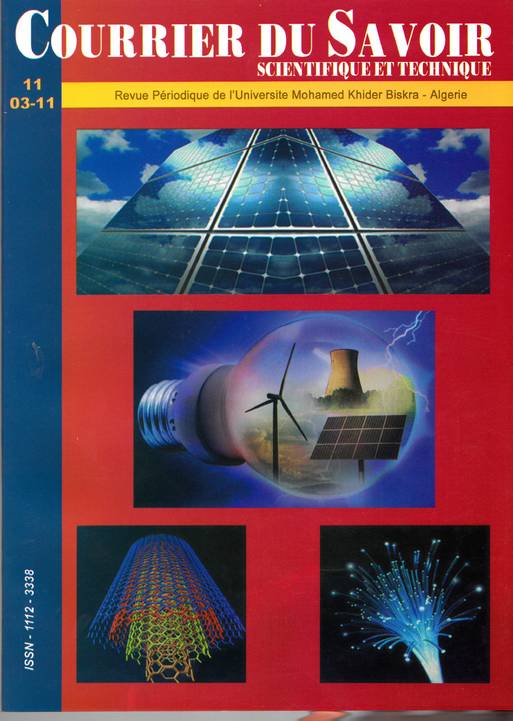ETUDE NUMERIQUE DE LA VARIATION DE TEMPERAURE DANS LE SOUDAGE A L’ARC ELECTRIQUE SOUS FLUX SOLIDE DES ACIERS A FAIBLES POURCENTAGE DE CARBONE
Résumé
Dans le soudage des aciers le rôle de l’étude numérique est nécessaire et utile dans l’estimation de la limite de la largeur de
valeur de la zone affectée thermiquement dite ZAT. Seulement quelques publications ont considéré au cours du soudage la
source de chaleur mobile lorsque celui-ci est en progression en fonction du temps, entre une température initiale et finale afin
de définir la variation de température et sa diffusion à travers la ZAT [1-4].
Dans ce travail, une méthode approximative de déduction de la largeur de la ZAT a été développée et a donner de raisonnables
résultats, avec cette approche proposée, une adéquate concordance entre la largeur de la ZAT déduite numériquement, les
températures de changements de phases des aciers et les valeurs de micro-dureté a été établie.
Aussi l’aspect original de recherche que comporte ce travail, du fait que celle-ci s’est effectuée lors d’un soudage en
progression et a été élaboré pour déduire :
L’effet du soudage automatique à l’arc électrique sur les propriétés mécaniques des aciers à faible pourcentage en
carbone en utilisant les épreuves de micro-dureté.
Identification exacte des valeurs de micro-dureté avec la détermination localisée de leurs lieux (proche et à
l’intérieure de la ZAT).
Numerical study is useful as well as necessary in the assessment of the width limit of the heat affected zone (HAZ) as far as
steel welding is concerned. Only limited published work has considered a mobile heat source to define the temperature
variation in industrial low carbon steel (0, 19 wt. % C) when welding is in progress between the initial and final welding time
[1-4].
In this present work, an approximate method of deducting HAZ width value has been developed and shown to give reasonable
results. The research aspects considered herein are as follows:
The effect of arc welding on microstructures, HAZ hardness and mechanical properties of industrial low carbon steel
is studied.
The different zones near the (HAZ) are identified and their exact size and location are determined.
An adequate agreement between calculated HAZ width value, steel phase change temperatures and HAZ hardness values has
been obtained.
Références
“HAZ microstructure simulation in welding of a ultra
fine grain steel” Computational Materials Science 31
(2004) p 379–388
[2] P.N. Sabapathy. M.A. Wahab and M.J. Painter
“Numerical models of in-service welding of gas
pipelines” Journal of Materials Processing Technology
118 (2001) p 14-18
[3] B. Taljat, B. Radhakrishnan, T. Zacharia “Numerical
analysis of GTA welding process with emphasis on
post-solidification phase transformation effects on
residual stresses” Materials Science and Engineering
A246 (1998) p 45–54.
[4] M. Abid, M. Siddique “Numerical simulation to study
the effect of tack welds and root gap on welding
deformations and residual stresses of a pipe-flange
joint” International Journal of Pressure Vessels and
Piping 82 (2005) p 860–87
[5] E. Bayaraktar, D. Kaplan, L. Devillers, J.P. Chevalier,
Journal of Materials Processing Technology 189
(2007) 114-125.
[6] A. Güral, B. Bostan, A.T. Özdemir, Materials and
Design 28 (2007) 897-903.
[7] M. Eroglu, M. Aksoy, Materials Science and
Engineering A286 (2000) 289-297.
[8] O. Grong, O.M. Akselsen, HAZ grain growth
mechanism in welding of low carbon microalloyed
steels. Acta Metall 1986, 34: 1807-15.
[9] C. Thaulow, AJ Paauw, A Gunleiksrud, OJ Naess,
Heat affected zone toughness of low carbon
microalloyed steel. Metal Construct 1985, 17/94-9.
[10] K. Ohaya, J. Kim, K. Yokoyama, M. Nagumo,
Microstructures relevant to brittle fracture initiation at
the heat-affected zone of weldement of low carbon
steel. Metal Mater Trans A 1996; 27:2574-82.
[11] Olabi AG, Hashmi MJS. The microstructure and
mechanical properties of low carbon steel welded
components after the application of PWHT. J Mater
Process Technol 1996;56:88-97.
[12] S.A.A. Akbari Mousavi, R. Miresmaeili
“Experimental and numerical analyses of residual
stress distributions in TIG welding process for 304L
stainless steel” journal of materials processing
technology (2008).
[13] S. Lars-Eric, Control of Microstructures and Properties
in Steel Arc Welds, Library of Congress Cataloging-in
Published Data, 1994.
[14] G.R. Stewart, A.M. Elwazri, R Varano, N.
Pokutylowicz, S. Yue and J.J. Jonas, Materials
Science and Engineering A420 ( 2006.) 115-12


